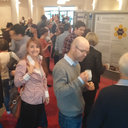Sex-dependent co-occurrence of hypoxia and β-amyloid plaques in hippocampus and entorhinal cortex is reversed by long-term treatment with ubiquinol and ascorbic acid in the 3 × Tg-AD mouse model of Alzheimer's disease.
キーワード
概要
Structural and functional abnormalities in the cerebral microvasculature have been observed in Alzheimer's disease (AD) patients and animal models. One cause of hypoperfusion is the thickening of the cerebrovascular basement membrane (CVBM) due to increased collagen-IV deposition around capillaries. This study investigated whether these and other alterations in the cerebrovascular system associated with AD can be prevented by long-term dietary supplementation with the antioxidant ubiquinol (Ub) stabilized with Kaneka QH P30 powder containing ascorbic acid (ASC) in a mouse model of advanced AD (3 × Tg-AD mice, 12 months old). Animals were treated from prodromal stages of disease (3 months of age) with standard chow without or with Ub + ASC or ASC-containing vehicle and compared to wild-type (WT) mice. The number of β-amyloid (Aβ) plaques in the hippocampus and entorhinal cortex was higher in female than in male 3 × Tg-AD mice. Extensive regions of hypoxia were characterized by a higher plaque burden in females only. This was abolished by Ub + ASC and, to a lesser extent, by ASC treatment. Irrespective of Aβ burden, increased collagen-IV deposition in the CVBM was observed in both male and female 3 × Tg-AD mice relative to WT animals; this was also abrogated in Ub + ASC- and ASC-treated mice. The chronic inflammation in the hippocampus and oxidative stress in peripheral leukocytes of 3 × Tg-AD mice were likewise reversed by antioxidant treatment. These results provide strong evidence that long-term antioxidant treatment can mitigate plasma oxidative stress, amyloid burden, and hypoxia in the AD brain parenchyma.


